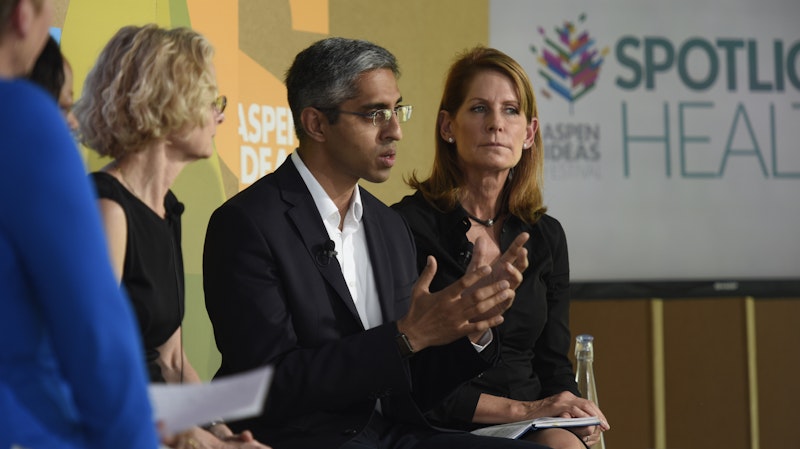
Deep Dive: The Opioid Tsunami

The opioid epidemic, and addiction more broadly, have become the defining public health crisis of our generation.
Full Session

Setup
Opioids are responsible for the worst drug epidemic ever to hit the United States. Shockingly, it is also the first one to have been “generated in the health care system,” says Nora Volkow. As physicians struggled to help patients suffering chronic pain, the pharmaceutical industry heavily promoted opioids and downplayed their abuse potential. Overdose deaths have risen steadily, quadrupling in the U.S. since 1999 as prescriptions soared.
The bright spot here is that addiction is increasingly recognized as a medical, not a criminal problem — a disease of the brain, not a disease of choice — and there are treatments that work.
Speakers
-
 Vivek MurthyU.S. Surgeon General at the U.S. Department of Health and Human Servic...
Vivek MurthyU.S. Surgeon General at the U.S. Department of Health and Human Servic... -
 Nora VolkowDirector, National Institute on Drug Abuse, National Institutes of Hea...
Nora VolkowDirector, National Institute on Drug Abuse, National Institutes of Hea... -
 Perri PeltzDocumentary Filmmaker
Perri PeltzDocumentary Filmmaker -
 Jackie JuddCommunications Consultant
Jackie JuddCommunications Consultant -
 Yasmin HurdWard-Coleman Chair in Translational Research and Director, Addictive I...
Yasmin HurdWard-Coleman Chair in Translational Research and Director, Addictive I...
- 2017 Health
Understanding opioids and the scope of the epidemic
Opioids include both prescription drugs, such as percocet and oxycontin, and illicit substances like heroin and fentanyl, which act on receptors in the brain to diminish pain and promote euphoria.
By the numbers
Why are opioids so addictive?
Yasmin Hurd explains the neurobiology of addiction. Addiction can result from the ability of opioids to pass the blood-brain barrier, bind rapidly to receptors in the brain, and trigger a signaling cascade in the cells.
Who knew?
Preventing addiction requires treating both emotional and physical pain
In a journey across the U.S., Murthy realized that an epidemic of chronic stress is causing deep emotional pain. Yet doctors who fail to find a physical cause for someone’s health complaint too often dismiss the symptoms as “just in your head.”
Murthy says that misses a central truth. “You can experience emotional pain as physical pain. What is in your head is very real and it can influence your perception of pain.”
We know how to treat opioid addiction— but we’re not doing enough of it
Nora Volkow describes three classes of drugs that provide effective treatment for opioid addiction. “When you treat opioid use disorder with any one of these medications you not only decrease the consumption of heroin or the opioid, you actually prevent overdoses, you prevent criminal behavior, you prevent them from recycling back into the prison system, and you improve the outcomes on your neonatal abstinence syndrome.”
Yet these treatments are underused, says Volkow. One reason is the stigma associated with their use, with some people arguing they just substitute one medication for another.
Another is the lack of infrastructure — there simply aren’t enough treatment programs to care for all of those who are addicted to opioids. Insurance gaps are also an obstacle.
Big IdeaThe health care system has always lagged behind in not considering addiction part of their responsibility, of not seeing it as a disease that they should be treating and screening.Nora Volkow
Can marijuana help treat opioid addiction?
Leading in to a discussion about the promise of marijuana to combat opioid use, Hurd reminds us that “an epidemic calls for a different way of thinking.” Pilot studies suggest that the cannabinoids in the plant appear to decrease heroin-seeking behavior and possibly alcohol abuse. Unlike the THC in marijuana, cannabinoids do not have a rewarding effect.
Murthy underscores the importance of science to drive decision making about the use of marijuana, but observes that the federal government still restricts research.
Regulating marijuana to treat opioid addiction
Learn More
Additional Information
Resources
Warning: The Drug May Kill You
Confronting Our Nation’s Opioid Crisis, A Report of the Aspen Health Strategy Group
Explore More
Science

Space… the final metaphor for the unknowable. But we are certainly trying to understand what goes on out there, and the more we learn, the more fascinating questions start to...

Since 2014, Aspen Ideas: Health has welcomed nearly 800 inspiring women leaders to our stages to share their bold approaches to better health. In honor of Women's History Mont...

Setting audacious goals helps to redefine what is achievable in health, medicine, and science. As we deepen understanding of the human genome, unravel the mysteries of the bra...


Research on aging and extending life and healthspan has ventured beyond humans to our best animal friends – dogs. In less than a year, dog owners may be able to buy a drug tha...

The recognition that all things are connected is at once a scientific principle and a philosophical touchstone. Humans, animals, and the environment are intertwined in complex...

For as long as humans have looked at the skies, we’ve speculated about whether there is life in space. Scientists, the U.S. military and the CIA have all searched for proof of...

It sounds like sci-fi: Scientists are beaming solar energy from space, subbing seaweed for plastic and brightening clouds to reflect sunlight to lower temperatures in a warmin...

*No food or service animals allowed in this session.* The creator of Fat Bear Week in Alaska gives insight on the importance of wildlife education, and then ecologists unpack...

Brain-computer interfaces show potential to restore function to people impacted by incurable neurological conditions such as stroke, spinal cord injury, traumatic brain injury...

Scientists are developing life-extending drugs for dogs, and new advancements could bring them to market by 2025. Two leaders working to slow the aging process for Fido discus...

Few people are more deeply steeped in science than Francis Collins, former director of the National Institutes of Health and the groundbreaking Human Genome Project, and forme...

Part 1. Contrary to Popular Opinion — Bill Maher in Real Time: The iconoclastic host of HBO’s “Real Time with Bill Maher” sits down with Tina Brown to talk about calling out...

The hormonal changes and hot flashes that accompany menopause are familiar to most women, but the accompanying brain changes have not received as much attention. We now know t...

The idea of gathering DNA samples into a vast database in order to identify disease risks and breakthrough therapies was once a distant dream. Not long ago, immunotherapy seem...

From in vitro fertilization (IVF), which combines human eggs and sperm outside the body, to in vitro gametogenesis (IVG), which uses stem cells to create gametes, pregnancy is...

The communities we call home and the ways we live greatly influence health and longevity. By studying “Blue Zones” around the globe, Dan Buettner has uncovered the macro-level...

The first drug in a class known as GLP-1 agonists was approved in 2005 to treat diabetes. GLP-1 drugs subsequently proved their mettle to treat obesity and prevent major cardi...

Scientific investigation is laser focused on psychedelics to treat post-traumatic stress disorder (PTSD), ease end-of-life anxiety, and address mental health challenges, inclu...

Artificial intelligence is generating enormous excitement for its potential to predict health risks, speed diagnoses, and guide medical decision making. At the same time, the...

The health benefits of a nutritious diet are well-established, but just telling people to eat more plant-based foods and less unhealthy fat isn’t enough to reduce the toll of...









